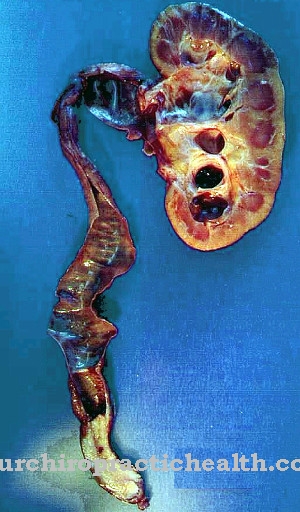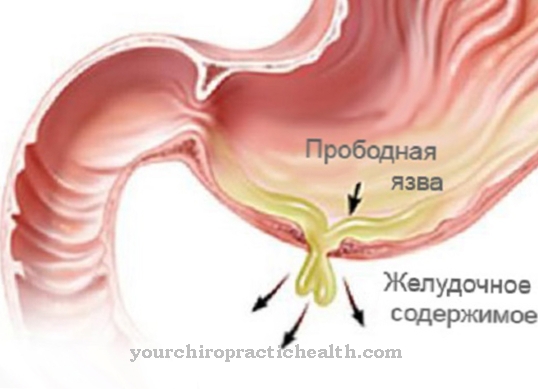Flexor tendon injuries on the hand severely limit the mobility and gripping ability of the fingers. Despite the anatomical peculiarities and the severity of the restrictions, there are now effective therapeutic methods that usually lead to the complete restoration of the functionality of the affected fingers.
What are flexor tendon injuries on the hand?

© Alila Medical Media - stock.adobe.com
Flexor tendon injuries to the hand are very problematic as the ability of the fingers to move is severely impaired. There are two flexor tendons on each individual finger, one superficial and one deep flexor tendon.
They represent the connection between the fingers and the flexor muscles of the forearm. The superficial flexor tendons are responsible for the flexion of the middle finger joint. The deep flexor tendons mainly flex the joints at the top of the fingers. But they also help to flex the middle and lower finger joints.
Each flexor tendon is covered by a tendon sheath that is additionally reinforced by cruciate ligaments and ring ligaments. The ligaments ensure that the tendons are guided close to the joints and bones. Because of these fine and special anatomical conditions, flexor tendon injuries to the hand are often complicated.
causes
Any injury to the flexor side of a finger can result in a flexor tendon injury. This applies to injuries with and without a skin cut. Often stab wounds and cuts, such as those caused by knives, cut-open cans or broken glass, lead to a severance of the flexor tendons.
Severe bruises and blunt force can also cause flexor tendon injuries. People who work on machines with sharp cutting surfaces, such as grinding devices and circular saws, are also at great risk of suffering such injuries. Animal bites are another cause.
In general, a rather strong force is necessary to cut the relatively strong flexor tendons, which have a diameter of about five to ten millimeters.
Symptoms, ailments & signs
The flexor tendon on the hand can be injured by various causes, and the symptoms and signs are just as different. However, every type of injury triggers severe pain and can range from restricted movement to almost complete immobility of the hand.
Injuries caused by external events are usually actively experienced and recognized by the patient. These can be cuts, bruises, bruises or strained tendons from sprains, in each case a specific event is the cause. In the case of open injuries, more or less severe bleeding can occur.
Injuries that are often not visible from the outside are tears or tears of the flexor tendon caused by external impulses. In these cases, the pain is immediate and severe with the onset of the injury. Other injuries to the flexor tendon in the hand result from prolonged overload, for example during unfamiliar physical work, long-term housework or during sports.
Here the complaints are often indicated for a long time, but are ignored in the early stages. A mostly dull, only in rare cases stabbing pain becomes noticeable. Due to the strain on the flexor tendon, the strength in the hand decreases, and symptoms of fatigue in addition to pain become noticeable. Often this also affects the gripping ability and grip strength of the fingers.
Diagnosis & course
Normally the fingers are in a natural, slightly bent position when the hand is held relaxed. In contrast, if the flexor tendon is injured in the hand, the fingers are stretched out unnaturally stiffly. Bruising and swelling often form.
If the deep flexor tendon is severed, the end joint of the corresponding finger cannot be flexed or can only be flexed with great difficulty. If the superficial and deep flexor tendons are severed at the same time, flexion of the middle joint is difficult or impossible.
In addition to the flexion function, blood circulation and finger feeling are also checked during the diagnosis in order to obtain information on vascular and nerve injuries. In the case of very complex flexor tendon injuries, an X-ray is also taken in order to identify possible injuries to the bones or hidden foreign bodies.
Complications
Flexor tendon injuries to the hand mean that the patient is relatively restricted in his everyday life and in his actions. The restrictions relate primarily to the ability to grip and the mobility of the hand and the individual fingers. Thus, for example, normal food intake is no longer possible, so that the person concerned is dependent on the help of other people in his everyday life.
Most of the time, the flexor tendon injuries to the hand also cause severe pain. The pain often leads to depression and other psychological complaints. The hand can swell and the pain can also appear in the form of pain at rest. Surgical treatment is usually carried out.
The earlier treatment is started, the better the chances of a complete cure without complications. Most of the time, after flexor tendon injuries, the patient cannot load the hand immediately and has to wait a certain period of time until full load-bearing capacity is restored. This period can be up to six months. After that there are no further complications or complaints. The fingers can then easily be stressed again.
When should you go to the doctor?
In the event of flexor tendon injuries to the hand, a doctor must be consulted immediately. This disease does not self-heal, so participation in various therapies is usually essential for the patient. It can also prevent further complications and possibly paralysis.
In the event of flexor tendon injuries to the hand, the doctor should be consulted if the fingers themselves are in an unnatural position or position, even if they are stretched. As a rule, the person affected can hardly or not at all stretch and bend their fingers, so that there are significant restrictions in everyday life.
Hand pain can also occur with flexor tendon injuries. Swelling and bruises can also indicate this condition and should be examined by a doctor. In acute emergencies or in severe pain, the hospital should be visited. The earlier the flexor tendon injuries on the hand are identified, the better the chances of complete healing. As a rule, however, a doctor should not be consulted for longer than 48 hours after the injury, since afterwards it is usually no longer possible to sew the tendons together.
Doctors & therapists in your area
Treatment & Therapy
If there is a flexor tendon injury to the hand, the severed tendons are sewn together as early as possible. Treatment should be given no later than 48 hours after the injury. The best chance of recovery is if the tendon stumps are brought back together within six hours of being cut. Due to the muscle pull, the tendon ends can slide back into the forearm area, which is why incisions have to be made in the palm of the hand or wrist in order to find them.
If the flexor tendon injury on the hand is infected or older, no direct suture is usually placed. Instead, a silicone stick is first placed in the tissue to prevent the tendon sheath from sticking together. This is followed by a second procedure in which the tendon is sewn together. A tendon transplant may also be necessary.
The freshly sewn tendon is not yet fully resilient. The injured finger may only be moved carefully, otherwise there is a risk that the tendon sheath will stick and the finger will become stiff. The Kleinert splint, specially developed for optimal follow-up treatment, ensures that the patient can actively and powerfully stretch the injured fingers, but only bend them passively and without power.
Rubber bands between the fingernail and the wrist ensure that the finger cannot be fully stretched. The splint can be removed about six weeks after the operation, and after about twelve weeks the finger can be fully stressed again.
Outlook & forecast
In most cases, a flexor tendon injury on the hand heals completely within a few months after surgery. The patient therefore has a good prospect of permanent freedom from symptoms. Approximately 6 weeks after an operation, the inserted splint is removed from the hand. Immediately afterwards, partial strain on the hand is possible. In the further self-healing process, the resilience of the hand increases steadily and well-being increases. After 12 weeks, the hand can normally be fully used again.
However, overexertion should be avoided so as not to relapse. Some patients have long-term complaints of symptoms such as sensitivity to the weather or discomfort from the scar on the hand. It may take a long time to fully strain the hand. This depends on the age of the patient and the individual regeneration possibilities of the body. Nevertheless, there are overall good prospects for recovery.
A prognosis for a severing or crushing the flexor tendons is less optimistic. Complications and thus changes in the healing process can also occur if the injury is treated late or if further bone damage is detected too late. In these cases the hand can be permanently impaired or the healing process can be significantly extended by several months.
prevention
There are no special measures to prevent flexor tendon injuries to the hand. Extreme caution is always required when handling sharp objects and machines as well as animals that have sharp teeth. People who value fully functional fingers, such as pianists, should try to avoid dangerous machines and objects. But since the chances of recovery from flexor tendon injuries to the hand are generally very good, even pianists can usually continue to do their job unimpaired.
Aftercare
Follow-up care for flexor tendon injuries to the hand is necessary for several reasons. On the one hand, it is a matter of restoring mobility as early as possible by preventing adhesions with the tissue through appropriate exercises. On the other hand, excessive loads must be avoided so that the injury does not break up again.
For the contrast between flexibility and protection, the judgment of the treating therapist and medical practitioner is decisive, especially at the beginning. Surgeons and movement therapists decide on the current resilience of the tissue after flexor tendon injuries to the hand. An individual therapy plan is often created as part of the aftercare.
The therapy exercises are shown to the patient by the therapist and, at the beginning, often carried out with their help. The patient can then practice at home and gradually improve the mobility and resilience of the structures. In the case of severe flexor tendon injuries to the hand, the occupational therapist can also help to restore the routine of everyday movements.
Aftercare also includes minimizing the risk of infection after surgery for flexor tendon injuries. This includes that the wound must be protected from contamination. It is also compulsory to rest after the operation until the surgeon allows the possible movements again. In the case of reddening, throbbing or swelling as classic signs of inflammation, a doctor should be consulted at an early stage, who can examine the wound.
You can do that yourself
The chances of complete healing are highest with an injury to the flexor tendon if severed tendon stumps are brought together again immediately, but no later than two days after the injury. The most important self-help measure is to take an injury to the hand that restricts the mobility of the fingers seriously and to see a doctor or hospital immediately.
After a surgical procedure, the restored tendon is not immediately fully resilient. The patient must be careful with the affected hand. Otherwise there is a risk that the tendon sheath will stick and stiffen the limb. If the attending physician prescribes a Kleinert splint, it must be worn.
Here it is extremely important that the patient be patient. The splint is usually removed again after six weeks at the earliest. After that, it usually takes another one and a half to two months until the tendon is fully loaded again and the hand can be used as it was before the injury.
Physiotherapy exercises can help accelerate healing and restore the affected fingers to full functionality.


.jpg)
























